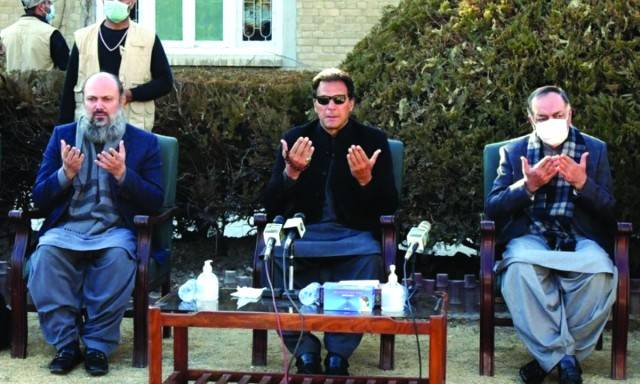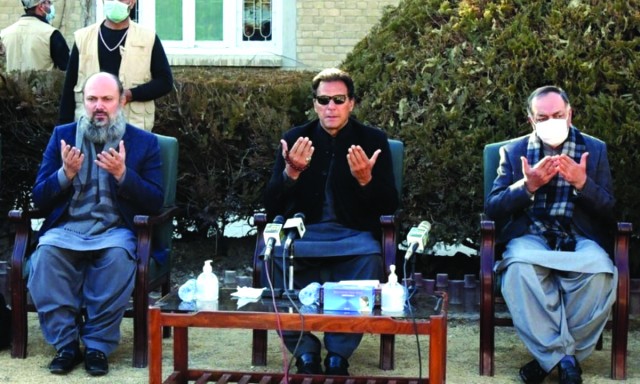
On January 3, 11 Hazara coalminers were brutally killed in the mountains of Mach town in Balochistan. This attack, which was claimed by the Pakistan chapter of the global terrorist organization Islamic State, triggered a wave of protests and condemnations all across the country. The main protest organized in Quetta was greatly mishandled by both the provincial and the federal governments.
Soon after the incident, relatives of the victims set up a protest camp on the western bypass area of Quetta. They were demanding many things, but their main demand was that Prime Minister (PM) Imran Khan should visit them and personally assure them that the Hazara community will be protected in the future.
However, PM Khan reacted to this demand in the most unwise manner. First, government officials hinted that the PM could not come to Quetta due to security concerns. Later, the PM delivered one of the most irresponsible speeches of his tenure so far. He said that the Hazaras were blackmailing him to visit Quetta and accept their demands.
This statement of PM received country-wide condemnation. Hassan Raza Changezi, a Hazara author and analyst, told TFT that this statement was highly irresponsible and the PM was rightly condemned for it, even though he tried to cover up for this blunder. Indeed, the PM later claimed that he had used the term blackmailing for his rival political alliance – PDM – and not the Hazaras as a community.

Meanwhile, as the protest was in progress, another group led by Sajjad Changezi launched a hunger strike camp outside Quetta press club against the derogatory remarks passed by the PM. This group of protestors demanded an apology from the PM for his remarks. The government of Balochistan, rather than listening to their demands, warned them that there were some serious security threats and that the government could not protect them. Still, the activists continued their protest.
At the peak of the sit-in and the protest, the chief minister of Balochistan was not present in Quetta. He was in Dubai and his political opponents alleged that he was having a vacation with his friends. Despite all the uproar over his absence, the CM took a couple to reach Quetta. Upon returning, he tried to justify his absence via Twitter and criticized his critics.
Soon the protests spread to Karachi, Lahore and other cities of the country. Karachi was especially affected as protestors blocked important arteries of the city in more than 10 locations. Social media in Pakistan was exploding with this issue and people were expecting the PM to visit Quetta and diffuse the situation. However, he remained adamant till the last moment that he would only visit once the coalminers had been buried.
This situation resulted in an impasse where both the government and the protestors did not want to concede on their stand. Then, the government devised a mischievous plan to force the protestors to end the sit-in. The government asked the protestors to provide identity documents of the slain coalminers to prove they were Pakistani citizens. If they were not Pakistani, then their bodies would be sent to Afghanistan, as per the demand of the Afghan government. Since most of the slain coalminers were Afghan nationals, the protests came under intense pressure to end the protest.
A religious edict also paved the way for the end to the sit-in. It is reported that a Shia cleric based in Iran issued an edict that bodies cannot be kept unburied for more than a couple of days. The bodies of slain coalminers remained unburied after more than five days, hence this edict created massive pressure for the protestors who are devout practitioners of the Shia sect.
There were also clear divisions between different stakeholders representing the Hazara community. Hazara Democratic Party (HDP), which is part of the Balochistan government, opposed the sit-in protest. Majlis-e-Wahdat e Muslimeen (MWM), which banks on Shia-religious sentiments within the Hazara community, was leading the protest sit-in. HDP alleged that MWM had hijacked the sit-in protest and was not allowing relatives of the victims to bury the coalminers.
The provincial government sweetened the pot and offered to pay Rs5 million compensation to the family of every victim on the spot, unlike the compensation payments which usually take months to materialize. In this scenario, the protestors were left with no choice but to end the protest without getting any assurance about their future safety. The next day, the hunger strike camp by Hazara activists was also called off.
PM Imran Khan visited Quetta the next day. He met the relatives of the victims under tight security on SBK Women’s University campus. During his exchange with the families of the victims, Khan said that he used to come to Hazara protests when he was a common person, but now that he was the PM, he could not repeat the same practice.
Hassan Raza Changezi said that the difference in the approach adopted by Imran Khan towards Hazaras when he was a common man and when he became PM was the root cause of the problem. “People are sympathetic towards Hazaras and their suffering when they are in opposition. However, the moment they join the government they become indifferent to their sufferings,” he told TFT.
The writer is a journalist and researcher. He can be reached on Twitter: @iAdnanAamir
Soon after the incident, relatives of the victims set up a protest camp on the western bypass area of Quetta. They were demanding many things, but their main demand was that Prime Minister (PM) Imran Khan should visit them and personally assure them that the Hazara community will be protected in the future.
However, PM Khan reacted to this demand in the most unwise manner. First, government officials hinted that the PM could not come to Quetta due to security concerns. Later, the PM delivered one of the most irresponsible speeches of his tenure so far. He said that the Hazaras were blackmailing him to visit Quetta and accept their demands.
This statement of PM received country-wide condemnation. Hassan Raza Changezi, a Hazara author and analyst, told TFT that this statement was highly irresponsible and the PM was rightly condemned for it, even though he tried to cover up for this blunder. Indeed, the PM later claimed that he had used the term blackmailing for his rival political alliance – PDM – and not the Hazaras as a community.

Meanwhile, as the protest was in progress, another group led by Sajjad Changezi launched a hunger strike camp outside Quetta press club against the derogatory remarks passed by the PM. This group of protestors demanded an apology from the PM for his remarks. The government of Balochistan, rather than listening to their demands, warned them that there were some serious security threats and that the government could not protect them. Still, the activists continued their protest.
At the peak of the sit-in and the protest, the chief minister of Balochistan was not present in Quetta. He was in Dubai and his political opponents alleged that he was having a vacation with his friends. Despite all the uproar over his absence, the CM took a couple to reach Quetta. Upon returning, he tried to justify his absence via Twitter and criticized his critics.
The situation resulted in an impasse where both the government and the protestors did not want to concede on their stand. Then, the government devised a mischievous plan to force the protestors to end the sit-in
Soon the protests spread to Karachi, Lahore and other cities of the country. Karachi was especially affected as protestors blocked important arteries of the city in more than 10 locations. Social media in Pakistan was exploding with this issue and people were expecting the PM to visit Quetta and diffuse the situation. However, he remained adamant till the last moment that he would only visit once the coalminers had been buried.
This situation resulted in an impasse where both the government and the protestors did not want to concede on their stand. Then, the government devised a mischievous plan to force the protestors to end the sit-in. The government asked the protestors to provide identity documents of the slain coalminers to prove they were Pakistani citizens. If they were not Pakistani, then their bodies would be sent to Afghanistan, as per the demand of the Afghan government. Since most of the slain coalminers were Afghan nationals, the protests came under intense pressure to end the protest.
A religious edict also paved the way for the end to the sit-in. It is reported that a Shia cleric based in Iran issued an edict that bodies cannot be kept unburied for more than a couple of days. The bodies of slain coalminers remained unburied after more than five days, hence this edict created massive pressure for the protestors who are devout practitioners of the Shia sect.
There were also clear divisions between different stakeholders representing the Hazara community. Hazara Democratic Party (HDP), which is part of the Balochistan government, opposed the sit-in protest. Majlis-e-Wahdat e Muslimeen (MWM), which banks on Shia-religious sentiments within the Hazara community, was leading the protest sit-in. HDP alleged that MWM had hijacked the sit-in protest and was not allowing relatives of the victims to bury the coalminers.
The provincial government sweetened the pot and offered to pay Rs5 million compensation to the family of every victim on the spot, unlike the compensation payments which usually take months to materialize. In this scenario, the protestors were left with no choice but to end the protest without getting any assurance about their future safety. The next day, the hunger strike camp by Hazara activists was also called off.
PM Imran Khan visited Quetta the next day. He met the relatives of the victims under tight security on SBK Women’s University campus. During his exchange with the families of the victims, Khan said that he used to come to Hazara protests when he was a common person, but now that he was the PM, he could not repeat the same practice.
Hassan Raza Changezi said that the difference in the approach adopted by Imran Khan towards Hazaras when he was a common man and when he became PM was the root cause of the problem. “People are sympathetic towards Hazaras and their suffering when they are in opposition. However, the moment they join the government they become indifferent to their sufferings,” he told TFT.
The writer is a journalist and researcher. He can be reached on Twitter: @iAdnanAamir

